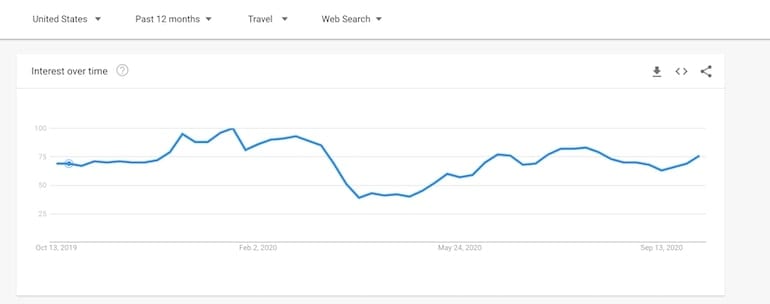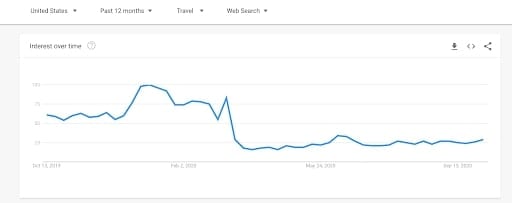In May of 2020 I discussed the need to relaunch PPC for the travel industry and in September of this year I discussed how the industry has changed and how PPC strategy needs to pivot accordingly. As we enter the holiday season, the busiest travel time of the year pre-COVID, the travel industry continues to evolve – and struggle. More people are searching and in the end, more people are traveling, but every advertising dollar counts in the race to win market share, solidify bookings and return to profitability.
Year Over Year Trends: What’s Changed
Private Vacation Rentals Are Booked Months in Advance
As I mentioned in September, hotels are now struggling to compete with home vacation rentals as the demand for home vacation rentals surges, and some travelers perceive private vacation rentals safer than traditional hotel stays. The benefit hotels now have is vacation rentals are booking one, two, sometimes many more months in advance, leaving travelers who are not planning out so far in advance with a shorter list of accommodation options. As holiday travel continues through the pandemic, and a comfortableness sets in, more travelers look to book hotels. “Hotels near me”, once the highest performing keyword during the height of the pandemic, has given way for those looking to travel various destinations across the United States, especially as holiday season nears.
Hotel Searches Return to 2019 Levels

This graph shows interest over time across the United States over the last 12 months for the keyword “Hotel”, according to Google Trends. Albeit a broad keyword, it tells the story that we are trending back on pace for hotel travel searches, outside of near me. Numbers represent search interest relative to the highest point on the chart for the given region and time. A value of 100 is the peak popularity for the term. A value of 50 means that the term is half as popular. A score of 0 means there was not enough data for this term. In October of 2019, this term had a score of 69 and now it holds a score of 76, slightly higher than where we were a year ago. In July, I wrote that “beachfront hotels near me” grew by 800% last month and “hotels with pools open near me” grew by 750%.

Air travel has not received as large of a bounceback as the hotel industry but in the graph above we see the interest for the term best flights has slowly evened out since its plummet in March. We are no longer seeing the drastic surges in travel related queries as the demand evens out. This is good for longevity and sustainability but it also requires you to pivot your PPC strategy.
Message Updates
The travel landscape is constantly changing and your ad copy needs to as well. This is not a time to get complacent with your ad copy as the mindset of travelers continues to shift.
- Remove any messaging referencing “we’ll see you when you’re ready”. You need to convey that the time to be ready is now and be confident in the travel options you provide.
- Continue to use sitelink extensions to link to your safety and precautions information page. It’s still viable information and it needs to be front and center.
- Highlight your re-opening or holiday offers. One of the biggest mistakes I’ve seen in travel ad messaging this year is not updating ad copy to leading with offers. The competition is trying to capture your customer as well.
- Highlight your differentiators. Searches are more specific than ever. Post-quarantine consumers are trending towards seeking out pools, waterfront locations, affordability and proximity. Your message can’t be everything to everyone. Bid on keywords that reflect your differentiators and put them front and center in your messaging as well.
- Test. Test your ad copy against new variations. If you have multiple offers, test those as well. It’s especially important to test new ad copy if you have been back to advertising for several months. The landscape has changed since then.
Location Targeting Expansion
Now is the time to expand your location targeting. When the hotel industry returned to PPC it was a best practice to only target certain locations within driving distance of your hotel(s) as most consumers were looking for getaways by car. As air travel continues to grow, so do the locations of your potential customer. The second step is to look at website traffic to determine which geographical locations show the most interest in your accommodations and open up your targeting to those locations. The third, and final step, is to consider opening your location targeting back up to the entire US. Ongoing keyword research and audience targeting will help ensure you control the quality of traffic to your ads.
Pause Poor Performing Keywords
Pausing poor performing keywords is a PPC best practice but it is even more crucial to stay on top of it during this time. Due to the nature of the pandemic and the industry, performing keywords change on a monthly, even weekly basis. In addition to the increased need for search term reports and uncovering new opportunities, keep an eye on keywords that may have once performed significantly and now need to be paused.
Revisit Your Campaign Structure
When travel companies began turning the lights back on with their advertising spend, it was all about awareness and top of funnel efforts. Many travel companies advertised under the assumption they’d be advertising at a loss. Some did, but some were pleasantly surprised to secure bookings. Now that travel planning is returning to normal, ensure your PPC campaigns include a full funnel approach. Don’t turn off the awareness search campaigns – expand to remarketing campaigns and begin to revisit display.




